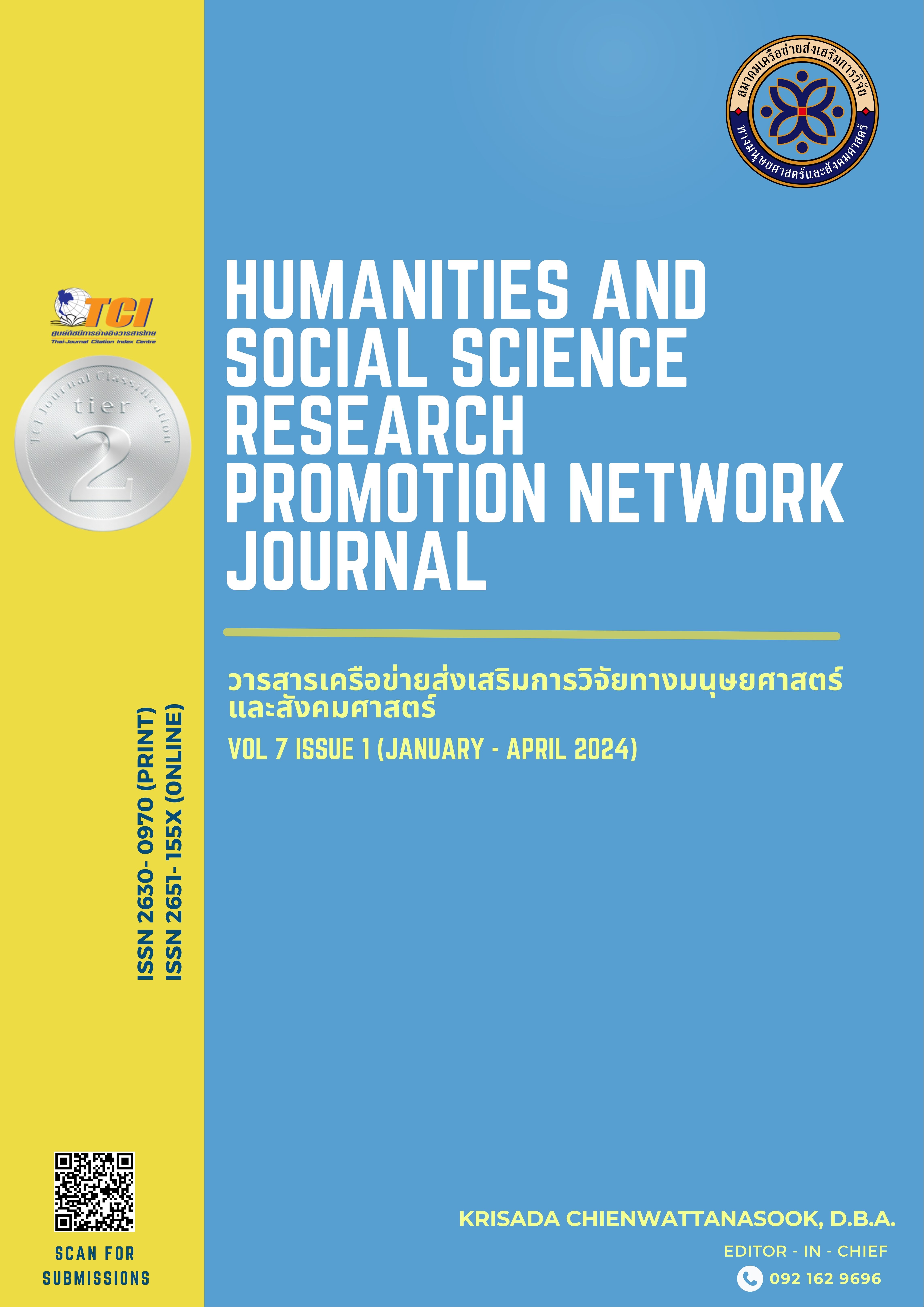กลยุทธ์การจัดการทรัพยากรมนุษย์แบบคล่องตัว: ปัจจัยการเห็นคุณค่าการทำงาน การเน้นเป้าหมาย และการสื่อสารแบบเครือข่าย
คำสำคัญ:
ความคล่องตัว, คุณค่าของงาน, การเน้นเป้าหมาย, การสื่อสารแบบเครือข่ายบทคัดย่อ
การจัดการองค์กรเพื่อให้มีความคล่องตัวสำหรับธุรกิจเป็นแนวทางหนึ่งที่พัฒนามาจากการเป็นองค์กรที่มีสมรรถนะสูง ทั้งนี้ปัจจัยสำคัญหนึ่งคือการจัดการแรงงานเชิงกลยุทธ์ให้มีความคล่องตัวอันประกอบด้วยการเน้นค่าของงาน การมุ่งเป้าหมายและการสื่อสารแบบเครือข่าย ด้วยปัญหาของธุรกิจขนาดเล็กและกลางในด้านทรัพยากร รวมทั้งยังเป็นธุรกิจที่เน้นการใช้แรงงานเป็นหลักส่งผลให้การจัดการเพื่อพัฒนาให้แรงงานมีความคล่องตัว ในการปรับตัวการทำงานอย่างว่องไวภายใต้การเปลี่ยนแปลงได้อย่างมีประสิทธิภาพ งานศึกษานี้ใช้ตัวแทนผู้บริหารจากธุรกิจ SME’s ของไทยมาเป็นตัวแทนจำนวน 250 ราย เพื่อทดสอบกับตัวแบบสมการโครงสร้างที่สังเคราะห์จากวรรณกรรม ผลการวิเคราะห์พบว่า ปัจจัยที่เป็นอุปสรรคในการที่จะสร้างความคล่องตัวให้แรงงาน คือ การสื่อสารแบบเครือข่ายที่ยังไม่ตอบสนองต่อแนวทางการจัดการทรัพยากรมนุษย์แบบคล่องตัว ส่วนปัจจัยการเห็นคุณค่าการทำงานนั้นยังมีอิทธิพลรวมเชิงบวกต่อปัจจัยผลลัพธ์ คือ พนักงานที่มีความคล่องตัว ในระดับต่ำคือค่าสัมประสิทธิ์สัมพันธ์เพียงร้อยละ 20 เท่านั้น
เอกสารอ้างอิง
ปัญพัชร์ ปภังกร. (2563). ปรับตัวให้ไวขึ้น ในโลก Disruption ด้วย Agility. https://sasinconsulting.com/wp-content/uploads/2020/09/Disruption_Agility.pdf
ลงทุนแมน. (2021). SMEs ไทย ผู้จ้างงาน 10 ล้านคนในประเทศ กำลังเจอวิกฤติ. https://www.longtunman.com/30931
Aghina, W, Ahlback, K., Smet, Aaron De, L., Gerald, L., Michael, M. M., & Handscomb, C. (2018). The five trademarks of agile organizations. Agile organizations-of any size and across industries-have five key elements in common. https://www.mckinsey.com/capabilities/people-and-organizational-performance/our-insights/the-five-trademarks-of-agile-organizations
Baek, P., Chang, J., & Kim, T. (2019). Organizational culture now and going forward. Journal of Organizational Change Management, 32(6), 650-668.
Bandura, A. (1997). Self-efficacy the exercise of control. W. H. Freeman and Company.
Bandura, A. (2002). Social cognitive theory in cultural context. Applied psychology, 51(2), 269-290. https://iaap-journals.onlinelibrary.wiley.com/doi/abs/10.1111/1464-0597.00092
Blumler, J. G., & Katz, E. (1974). The uses of mass communications: Current perspectives on gratifications research. Sage. https://eric.ed.gov/?id=ED119208
Burt, R. (2000). Decay functions. Social Networks, 22, 1-28. https://www.sciencedirect.com/science/article/pii/S0378873399000155
Dahmaradeh, N. & Banihashemi, S. A. (2010). Organizational agility and agile manufacturing. European Journal of Economics, Finance and Administrative Science, I27, 178 – 184.
Denning, S. (2012) Leadership Strategy Is Apple Truly Forbes 'Agile'? https://www.forbes.com/sites/stevedenning/2012/02/03/is-apple-truly-agile/?sh=f1488e9641e6
Erikson, K.M., Dorman, D. C., Lash, L.H., & Aschner, M. (2008) Duration of airborne-manganese exposure in rhesus monkeys is associated with brain regional changes in biomarkers of neurotoxicity. Neurotoxicology, 29, 377-385.
Fagerholm, F., & Pagels, M. (2014). Examining the structure of lean and agile values among software developers. Agile Processes in Software Engineering and Extreme Programming in Lecture Notes of the 15th International Conference (pp. 218-233). Rome, Italy, Vol. 179, Springer, Cham. https://link.springer.com/chapter/10.1007/978-3-319-06862-6_15
Gieles, H., & van der Meer, W. (2017). Talent management as the beating heart of an Agile Organization (White paper). https://www.prowareness.nl/wp-content/uploads/2017/05/agile-hr-whitepaper.pdf
Hair, J., Anderson, R., Tatham, R.L., & Black, W.C. (1998). Multivariate data analysis (5th ed.). Prentice-Hall.
Kelley, B. (2016). Human-Centered Change and Innovation. https://bradenkelley.com/2016/02/increasing-organizational-agility/
Locke, E. A., & Latham G. P. (2002). Building a Practically Useful Theory of Goal Setting and Task Motivation. American Psychologist, 57(9), 705–717.
Lunenburg, F. (2011). Goal-Setting Theory of Motivation. International Journal of Management, Business, and Administration, 15(1), Sam Houston State University.
Lyons, S. T., Higgins, C. A., & Duxbury, L. E. (2010). Work values: Development of a new three-dimensional structure based on confirmatory smallest space analysis. Journal of Organizational Behaviour, 31, 969-1002.
Mavengere N. B. (2013). Role of Information Systems for Strategic Agility in Supply Chain Setting: Telecommunication Industry Study. The Electronic Journal Information Systems Evaluation, 16(4), 44-73.
Moon, T., Chu, W., Li, L., Zheng, Z., & Chang, Y. 2012. An online learning framework for refining recency search results with user click feedback. ACM Transactions on Information Systems, 30(4), Article 20. http://doi.acm.org/10.1145/2382438.2382439
Olkkonen, R., Tikkanen, H., & AlajoutsijaÈrvi, K. (2000). The role of communication in business relationships and networks. Management Decision, 38(6), 403-409.
Patel, P. C., & Conklin, B. (2012). Perceived Labor Productivity in Small Firms—The Effects of High–Performance Work Systems and Group Culture through Employee Retention. Entrepreneurship Theory and Practice, 36(2), 205–235.
Powell, W. W., White, D. R., Koput, K. W., & Owen-Smith, J. (2005). Network dynamics and field evolution: The growth of interorganizational collaboration in the life sciences. American Journal of Sociology, 11, 1132-1205.
Sawilowsky, S. S. (2009). New effect size rules of thumb. Journal of modern applied statistical methods, 8(2), Article 26.
Schermelleh-Engel, K., Moosbrugger, H., & Müller, H. (2003). Evaluating the Fit of Structural Equation Models: Tests of Significance and Descriptive Goodnessof-Fit Measures. Methods of Psychological Research Online, 8(2), 23-74.
Scupola, A., (2009). SMEs 'E-commerce adoption: Perspectives from Denmark and Australia. Journal of Enterprise Information Management, 22, 1-2.
Seleim, A., Ashour, A., & Bontis, N. (2007). Human capital and organizational performance: a study of Egyptian software companies. Management Decision, 45(4), 789-801.
Šochová, Z., & Kunce, E. (2014). Agilní Metody Řízení Projektů (1st ed.). Computer Press.
Stanton, J. M. (2001). Galton, Pearson, and the Peas: A Brief History of Linear Regression for Statistics Instructors. Journal of Statistics Education, 9(3). https://doi.org/10.1080/10691898.2001.11910537
Super, D. E. (1953). A theory of vocational development. American psychologist, 8(5),185.
Tabachnick, B. G., & Fidell, L. S. (2007). Using Multivariate Statistics (5th ed.). Allyn and Bacon.
Taylor, F. W. (1911). The principles of scientific management. NuVision Publications, LLC. 10 Tips for Being More Goal-Oriented at Work (May 27, 2021). https://www.indeed.com/career-advice/career-development/being-goal-oriented-at-work.
Tyagi, R. K., & Sawhney, M. S. (2009). High-Performance Product Management: The Impact of Structure, Process, Competencies, and Role Definition. Journal of Product Innovation Management, 27(1), 83-96.
Weber, G. Y., & Tarba, S. Y. (2014). Strategic Agility: A state of the Art, Introduction to the special section on strategic agility. California Management Review, 56(3), 5-12.
Westland, J. C. (2010). Lower bounds on sample size in structural equation modeling. Electronic commerce research and applications, 9(6), 476-487.
Wilson, C. (2012). Strategic engagement and alignment of corporate talent. Development and Learning in Organisations, 26(5), 4-8.
Xetta International Enquiry. (2021). Agile Organisation Trademarks. https://xetta.com/resources/the-5-trademarks-of-agile-organisations/
Xie, X. M., Zeng, S. X., & Tam, C. M. (2010). Overcoming barriers to innovation in SMEs in China: A perspective-based cooperation network. Innovation: Management, policy & practice, 12, 298-310.
Ying, L., & Ramamurthy, K. (2011). Understanding The Link between Information Technology Capability and Organizational Agility: An Empirical Examination. MIS Quarterly, 35(4) 931-954.
Žitkienė, R., & Deksnys, M. (2018). Organizational Agility Conceptual Model. Montenegrin Journal of Economics, 14(2), 115-129.
ดาวน์โหลด
เผยแพร่แล้ว
รูปแบบการอ้างอิง
ฉบับ
ประเภทบทความ
สัญญาอนุญาต
ลิขสิทธิ์ (c) 2024 ชรัณ เลิศธีรพจน์, ระพีพรรณ พิริยะกุล, นรพล จินันท์เดช

อนุญาตภายใต้เงื่อนไข Creative Commons Attribution-NonCommercial-NoDerivatives 4.0 International License.
บทความที่ได้รับการตีพิมพ์เป็นลิขสิทธิ์ของ ผู้เขียน
ทัศนะและความคิดเห็นที่ปรากฏในบทความในวารสารเครือข่ายส่งเสริมการวิจัยทางมนุษยศาสตร์และสังคมศาสตร์จะถือเป็นความรับผิดชอบของผู้เขียนบทความนั้น และไม่ถือเป็นทัศนะและความรับผิดชอบของกองบรรณาธิการ








